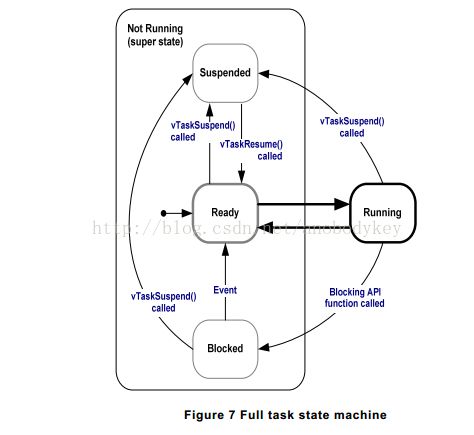FreeRTOS学习笔记——任务延时
主机环境:Windows
开发环境:MDK4.7.2
FreeRTOS版本:FreeRTOS8.1.2
目标环境:STM32F030C8T6
FreeRTOS的任务有以下几种状态:运行态、就绪态、阻塞态、挂起态,如下图
其中如果任务调用了延时函数就会进入阻塞态,延时函数有两个:vTaskDelay()和vTaskDelayUtil()前者是相对延时,后者是绝对延时,可以查看Using the FreeRTOS Real Time Kernel - a Practical Guide文档来帮助理解。先来了解一下vTaskDelay()函数吧,代码如下
void vTaskDelay( const TickType_t xTicksToDelay )
{
TickType_t xTimeToWake;
BaseType_t xAlreadyYielded = pdFALSE;
/* A delay time of zero just forces a reschedule. */
if( xTicksToDelay > ( TickType_t ) 0U )
{
configASSERT( uxSchedulerSuspended == 0 );
vTaskSuspendAll();
{
traceTASK_DELAY();
xTimeToWake = xTickCount + xTicksToDelay;
/* We must remove ourselves from the ready list before adding
ourselves to the blocked list as the same list item is used for
both lists. */
if( uxListRemove( &( pxCurrentTCB->xGenericListItem ) ) == ( UBaseType_t ) 0 )
{
/* The current task must be in a ready list, so there is
no need to check, and the port reset macro can be called
directly. */
portRESET_READY_PRIORITY( pxCurrentTCB->uxPriority, uxTopReadyPriority );
}
else
{
mtCOVERAGE_TEST_MARKER();
}
prvAddCurrentTaskToDelayedList( xTimeToWake );
}
xAlreadyYielded = xTaskResumeAll();
}
else
{
mtCOVERAGE_TEST_MARKER();
}
/* Force a reschedule if xTaskResumeAll has not already done so, we may
have put ourselves to sleep. */
if( xAlreadyYielded == pdFALSE )
{
portYIELD_WITHIN_API();
}
else
{
mtCOVERAGE_TEST_MARKER();
}
}
void vTaskSuspendAll( void )
{
/* A critical section is not required as the variable is of type
BaseType_t. Please read Richard Barry's reply in the following link to a
post in the FreeRTOS support forum before reporting this as a bug! -
http://goo.gl/wu4acr */
++uxSchedulerSuspended;
}
static void prvAddCurrentTaskToDelayedList( const TickType_t xTimeToWake )
{
/* The list item will be inserted in wake time order. */
listSET_LIST_ITEM_VALUE( &( pxCurrentTCB->xGenericListItem ), xTimeToWake );
if( xTimeToWake < xTickCount )
{
/* Wake time has overflowed. Place this item in the overflow list. */
vListInsert( pxOverflowDelayedTaskList, &( pxCurrentTCB->xGenericListItem ) );
}
else
{
/* The wake time has not overflowed, so the current block list is used. */
vListInsert( pxDelayedTaskList, &( pxCurrentTCB->xGenericListItem ) );
/* If the task entering the blocked state was placed at the head of the
list of blocked tasks then xNextTaskUnblockTime needs to be updated
too. */
if( xTimeToWake < xNextTaskUnblockTime )
{
xNextTaskUnblockTime = xTimeToWake;
}
else
{
mtCOVERAGE_TEST_MARKER();
}
}
}接着唤醒调度器
BaseType_t xTaskResumeAll( void )
{
TCB_t *pxTCB;
BaseType_t xAlreadyYielded = pdFALSE;
/* If uxSchedulerSuspended is zero then this function does not match a
previous call to vTaskSuspendAll(). */
configASSERT( uxSchedulerSuspended );
taskENTER_CRITICAL();
{
--uxSchedulerSuspended;
if( uxSchedulerSuspended == ( UBaseType_t ) pdFALSE )
{
if( uxCurrentNumberOfTasks > ( UBaseType_t ) 0U )
{
/* Move any readied tasks from the pending list into the
appropriate ready list. */
while( listLIST_IS_EMPTY( &xPendingReadyList ) == pdFALSE )
{
pxTCB = ( TCB_t * ) listGET_OWNER_OF_HEAD_ENTRY( ( &xPendingReadyList ) );
( void ) uxListRemove( &( pxTCB->xEventListItem ) );
( void ) uxListRemove( &( pxTCB->xGenericListItem ) );
prvAddTaskToReadyList( pxTCB );
/* If we have moved a task that has a priority higher than
the current task then we should yield. */
if( pxTCB->uxPriority >= pxCurrentTCB->uxPriority )
{
xYieldPending = pdTRUE;
}
else
{
mtCOVERAGE_TEST_MARKER();
}
}
/* If any ticks occurred while the scheduler was suspended then
they should be processed now. This ensures the tick count does
not slip, and that any delayed tasks are resumed at the correct
time. */
if( uxPendedTicks > ( UBaseType_t ) 0U )
{
while( uxPendedTicks > ( UBaseType_t ) 0U )
{
if( xTaskIncrementTick() != pdFALSE )
{
xYieldPending = pdTRUE;
}
else
{
mtCOVERAGE_TEST_MARKER();
}
--uxPendedTicks;
}
}
else
{
mtCOVERAGE_TEST_MARKER();
}
if( xYieldPending == pdTRUE )
{
#if( configUSE_PREEMPTION != 0 )
{
xAlreadyYielded = pdTRUE;
}
#endif
taskYIELD_IF_USING_PREEMPTION();
}
else
{
mtCOVERAGE_TEST_MARKER();
}
}
}
else
{
mtCOVERAGE_TEST_MARKER();
}
}
taskEXIT_CRITICAL();
return xAlreadyYielded;
}接着下面判断了在调度器挂起期间是否有时间中断发生,当uxPendedTicks的值大于0时表明在调度器挂起期间有SysTick中断发生,这里需要处理,以确保延时任务在正确的时间唤醒,在代码中是根据uxPendedTicks的数值来循环调用下TaskIncrementTick()函数,直到uxPendedTIcks值变为0,并根据需要更新xYieldPending的值,最后如果启用抢占式调用的话则标记xAlreadyYielded的值为pdTRUE,并调用taskYIELD_IF_USING_PREEMPTION()宏来执行任务切换,该宏最后也是调用vPortYield()函数,产生一次NVIC_PENDSV中断以此来执行任务切换,当然这次任务切换不会立即执行因为还没退出临界区代码,最后退出临界区并返回xAlreadyYielded值。该值在vTaskDelay()中还要用到,如果已经产生了任务切换则在vTaskDelay()函数中就不再产生任务切换,vTaskDelay()函数也就分析完毕了。该函数的分析应该和SysTick中断一起分析才好理解我觉得,留待下回吧。。。